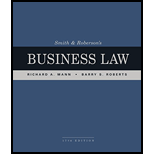
To discuss: The constitutional law’s fundamental principles.
Explanation of Solution
The constitutional law’s fundamental principles are as follows:
Pre-emption and federal supremacy: It means the federal government’s right to control the matters inside it authorities to the prospective elimination of the regulation of the state.
Federalism: The authority to rule is shared among the state and federal government. Any authority particularly given to the federal government are set aside to the persons and states.
Powers separation: The distribution of authority between the legislative, judicial and executive government branches to stop any government branch from attaining more authority. It allows operation of each branch without inference from any other branch.
Judicial review: It is the process of analysing actions of government to conclude whether they follow to the constitution of country U.
Action of state: State action means the actions of state, central and their subdivisions like country or city governments as disparate to the movements of secluded persons.
Want to see more full solutions like this?
Chapter 4 Solutions
Smith and Roberson’s Business Law
- This was the question asked of Jack Otto, production supervisor, by one of his manufacturing workers, Clyde Fisher. Jack had been wondering the same thing for several weeks about Bob Hill, another of his welders. Jack Otto is a 54-year-old production supervisor who has been with Store Fixture Manufacturing Co. (SFM) for 20 years. He is well liked and respected by his peers and subordinates and is very competent at the technical aspects of his supervisory job. Bob Hill, 40 years old, has been a generally competent and productive welder at SFM for ten years. Bob has been popular with his coworkers. Although he periodically "blows up" at them, he always apologizes afterward. His absenteeism rate has been higher than average for the last several years, with most absenteeism on Mondays. Also, it is not uncommon for Bob to be 10–15 minutes late at least once a week. But, because of a shortage of experienced welders and because Bob often cuts his lunch hour short to make up his tardiness…arrow_forwardSince the mid-1950s the proportion of American workers represented by unions has: A. Decreased. B. Grown only in the manufacturing sector. C. Remained about the same. D. Increased.arrow_forwardThe Occupational Safety and Health Act gives workers the right to a job: A. With wages that enable an employee to enjoy a decent standard of living. B. That does not require them to lift, bend, or move items at any time on the job. C. That is free from recognized hazards that are likely to cause death or serious injury. D. With equal wages for similar kinds of work.arrow_forward
- The right to a safe and healthy workplace is accurately described by which statement? A. Extensive training and careful precautions are necessary to avoid accidents, injuries, and illness. B. Regulations and enforcement have failed to curb worker accidents. C. Over recent years no new categories of accidents or illnesses have emerged. D. A very limited number of jobs are potentially hazardous to workers’ safety and health.arrow_forwardThe employment relationship: A. Indicate that employees are dependent on their employers for their livelihoods. B. Implies that employers depend on employees to make products, provide services, and run the organization internally. C. Refers to the relationship between employee and employer. D. All of these answers are correct.arrow_forwardThe employment relationship: A. Indicate that employees are dependent on their employers for their livelihoods. B. Implies that employers depend on employees to make products, provide services, and run the organization internally. C. Refers to the relationship between employee and employer. D. All of these answers are correct.arrow_forward
- Since the mid-1950s the proportion of American workers represented by unions has: A. Decreased. B. Grown only in the manufacturing sector. C. Remained about the same. D. Increased.arrow_forwardRomantic relationships in the workplace are described by which statement? A. Most businesses have strict policies forbidding all romantic relationships in the workplace. B. Almost all businesses ban romantic relationships between employees in the different departments. C. OSHA requires businesses to forbid workplace romantic relationships. D. Many companies allow managers to become romantically involved with subordinates, so long as they do not supervise them directly.arrow_forwardA reason for an increase in employee monitoring does not include: A. To make sure employees do not disclose confidential information. B. To reduce the employer's health insurance premiums. C. To avoid lawsuits if employees act in inappropriate ways. D. To achieve greater efficiency at work.arrow_forward
- A strong employer-employee relationship is central to: A. Achieving a corporation's environmental goals. B. Increasing the gross domestic product of a nation. C. None of these answers are correct. D. Satisfying the wishes of those who contribute their skills and talents to the company.arrow_forwardThe right to a safe and healthy workplace is accurately described by which statement? A. Extensive training and careful precautions are necessary to avoid accidents, injuries, and illness. B. Regulations and enforcement have failed to curb worker accidents. C. Over recent years no new categories of accidents or illnesses have emerged. D. A very limited number of jobs are potentially hazardous to workers’ safety and health.arrow_forwardEmployees in the United States have a legal right to: A. Organize and bargain collectively. B. A job. C. All these answers are correct. D. Months of vacation each year.arrow_forward
 Purchasing and Supply Chain ManagementOperations ManagementISBN:9781285869681Author:Robert M. Monczka, Robert B. Handfield, Larry C. Giunipero, James L. PattersonPublisher:Cengage Learning
Purchasing and Supply Chain ManagementOperations ManagementISBN:9781285869681Author:Robert M. Monczka, Robert B. Handfield, Larry C. Giunipero, James L. PattersonPublisher:Cengage Learning

